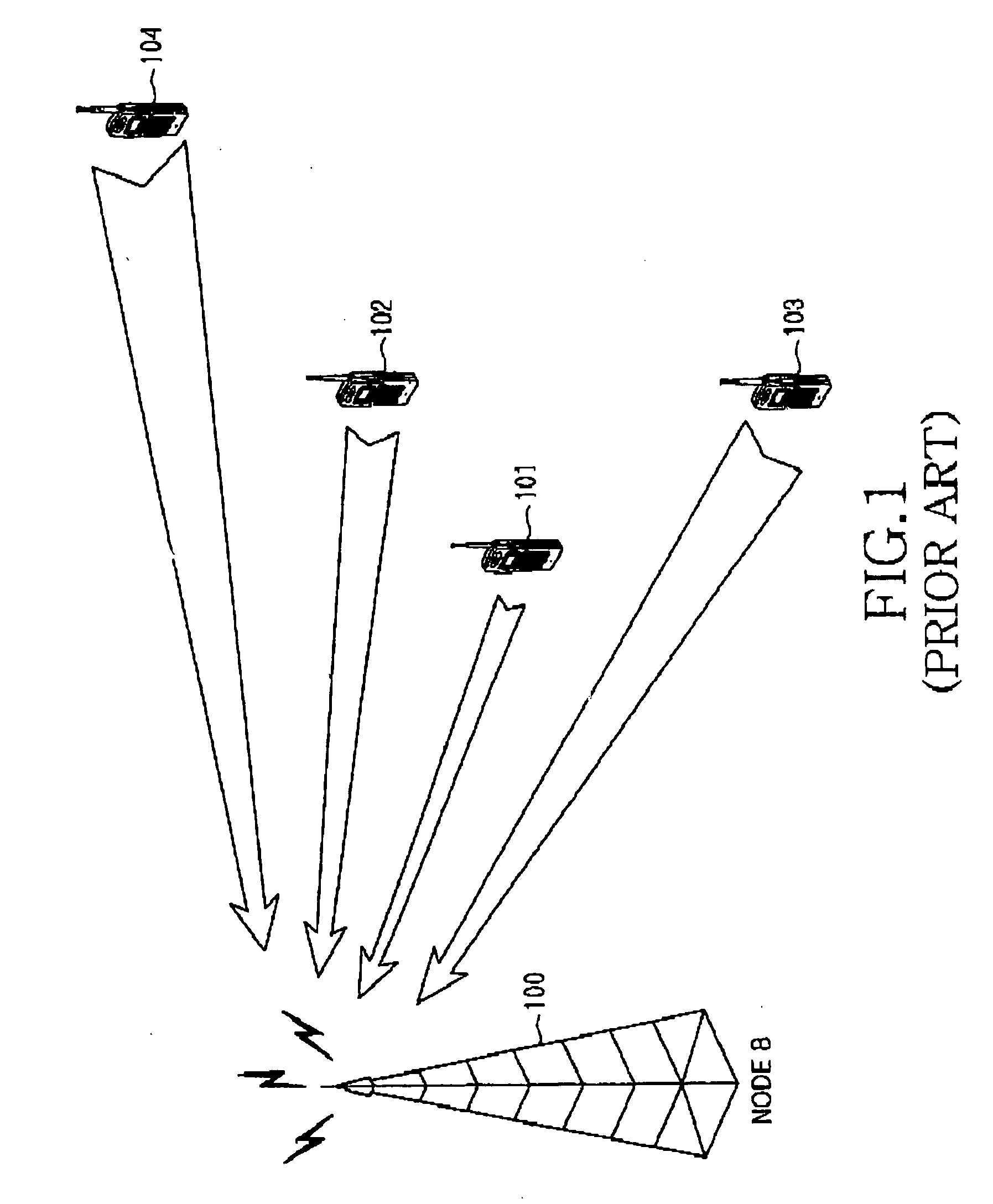Method of transmitting scheduling information on an enhanced uplink dedicated channel in a mobile communication system
a mobile communication system and dedicated channel technology, applied in the field of transmitting scheduling information, can solve the problems of increasing papr (peak), increasing complexity, and difficult to support efficient transmission of scheduling information by physical layer signaling with a limited slot format, and achieve the effect of reliable transmission of scheduling information
- Summary
- Abstract
- Description
- Claims
- Application Information
AI Technical Summary
Benefits of technology
Problems solved by technology
Method used
Image
Examples
first embodiment
[0045] Uplink data is transmitted on the conventional E-DCH for a PHY layer transmission period, TTI (Transmission Time Interval) and, at the same time, a MAC-e control PDU including scheduling information is transmitted on another E-DCH.
[0046] The MAC-e entity of the UE reports to the Node B the amount of buffered data as scheduling information. The Node B then allocates a maximum data rate to the UE based on the scheduling information. The UE transmits packet data at or below the allocated maximum data rate, or at a minimum data rate when no data rate is allocated to the UE. Thereafter, the UE transmits scheduling information according to a predetermined rule.
[0047]FIG. 3 illustrates E-DCH transmission according to an embodiment of the present invention. The E-DCH transmission operation includes a procedure 301 for transmitting data on a second E-DCH (E-DCH #2) and a procedure 310 for transmitting scheduling information on a first E-DCH (E-DCH #1).
[0048] Referring to FIG. 3, in...
second embodiment
[0070] While a MAC-e data PDU and a MAC-e control PDU are delivered on different E-DCHs, only one type of E-DCH is allowed for transmission for one TTI. Compared to the first embodiment of the present invention where both the MAC-e data PDU and MAC-e control PDU are transmitted simultaneously, the separate MAC-e PDU transmission eliminates Node B transmit power dissipation and HARQ complexity, which might otherwise be caused by transmission of a plurality of ACK / NACK signals to each UE.
[0071] The UE uses different E-DHCs in transmitting PDUs having different attributes, but transmits only one PDU for one TTI rather than simultaneously transmit them. While this embodiment adopts the channel configuration illustrated in FIG. 3, a TFC is selected such that a plurality of E-DCHs are not multiplexed for one TTI.
[0072] Exemplary E-TFCs for transmitting one E-DCH for one TTI are given in Table 2 below.
TABLE 2TFS for E-DCH #1TF0, TF1TFS for E-DCH #2TF0, TF1, TF2(E-TFC)(E-DCH #1, E-DCH #...
third embodiment
[0076] One E-DCH is transmitted for one TTI and transmission of a MAC-e control PDU is notified by a TF used to demodulate the E-DCH. More specifically, the UE transmits an indicator indicating transmission of a MAC-e control PDU including scheduling information. Preferably the indicator is a predetermined TF.
[0077] When necessary, the UE transmits a MAC-e control PDU including scheduling information or a MAC-e data PDU including packet data on one E-DCH. In the former case, the UE transmits an indicator indicating the MAC-e control PDU on an additional control channel.
[0078] If the indicator indicates that a received MAC-e PDU is a MAC-e control PDU including scheduling information, the Node B provides the MAC-e PDU to a MAC-e controller. If the indicator indicates that the received MAC-e PDU is a MAC-e data PDU, the Node B stores the MAC-e PDU in a reordering buffer so that it can be transmitted to an upper layer. A MAC-e controller reads information about buffer status and / or p...
PUM
 Login to View More
Login to View More Abstract
Description
Claims
Application Information
 Login to View More
Login to View More - R&D
- Intellectual Property
- Life Sciences
- Materials
- Tech Scout
- Unparalleled Data Quality
- Higher Quality Content
- 60% Fewer Hallucinations
Browse by: Latest US Patents, China's latest patents, Technical Efficacy Thesaurus, Application Domain, Technology Topic, Popular Technical Reports.
© 2025 PatSnap. All rights reserved.Legal|Privacy policy|Modern Slavery Act Transparency Statement|Sitemap|About US| Contact US: help@patsnap.com



